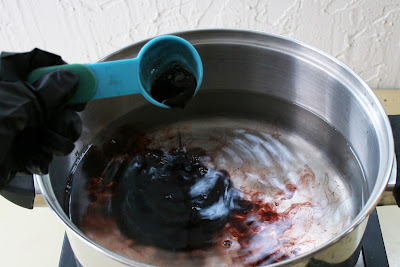What you'll need:
gloves
wool: fiber or yarn
acid dye stocks: brown, magenta, black (how to mix dye stock)
acid: citric or vinegar
dye pot: stainless steel or crock pot
measuring spoons
I'll be using 1 oz bundles of mixed breed wool combed top for each dye pot.
Gather the wool and soak in some room temp tap water until saturated.
Fill the dye pot up with a few inches of water and add 1/2 tsp of citric acid or 1 TB vinegar.
Add 1 TB brown dye stock.
Next, add 1/2 tsp of Magenta dye stock.
Add the damp wool to the pot making sure it is fully submerged.
Cover pot and turn heat to low. Simmer for about 20 minutes. Water will be clear when done.
Let cool.
Prepare rinse baths and hang dry.
We've got a pretty shade of puce!
Variations:
I added only 1/2 of the dye recipe here.
This dye pot is the main recipe with 1/4 tsp of Black dye stock added.
Here I added and 1 extra TB of Brown dye stock to the main recipe.
I doubled the recipe in this batch.
Have fun and keep on dyeing!
xo
Next on Mixed-Up Monday, 2/22: Camel


















































